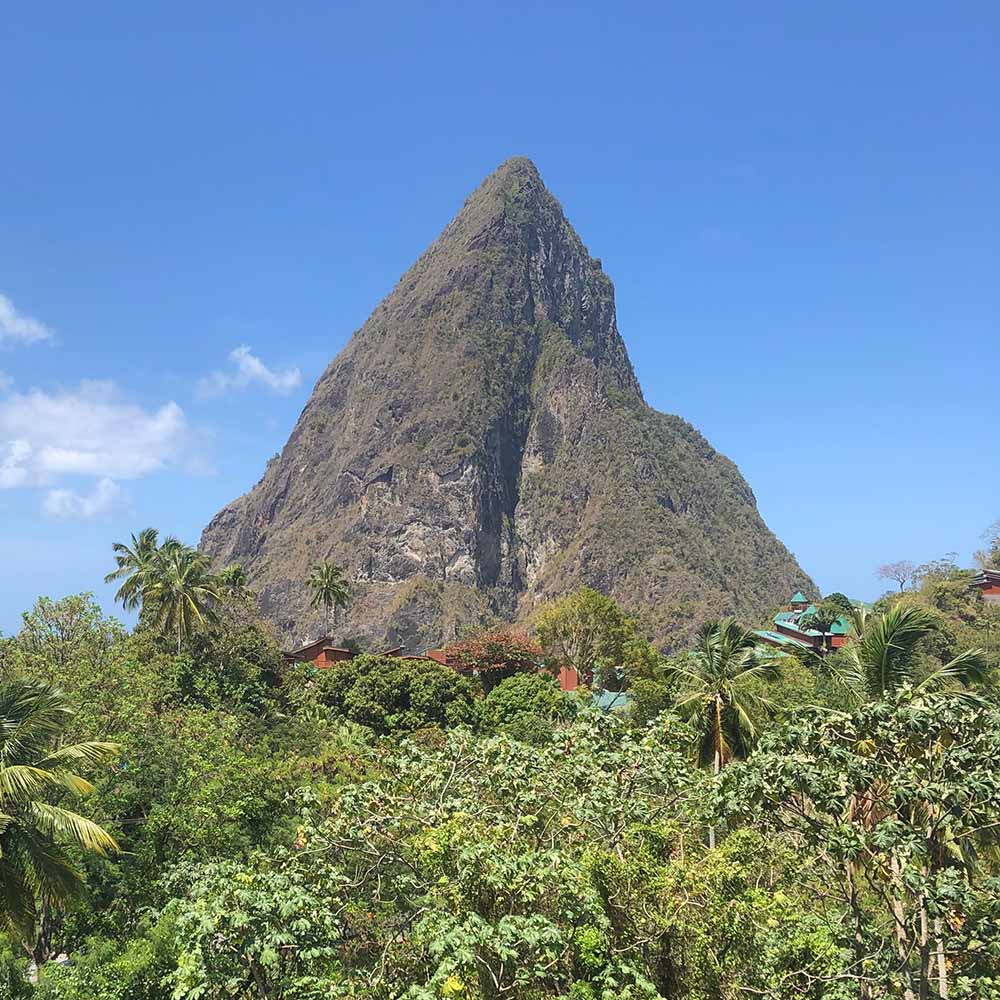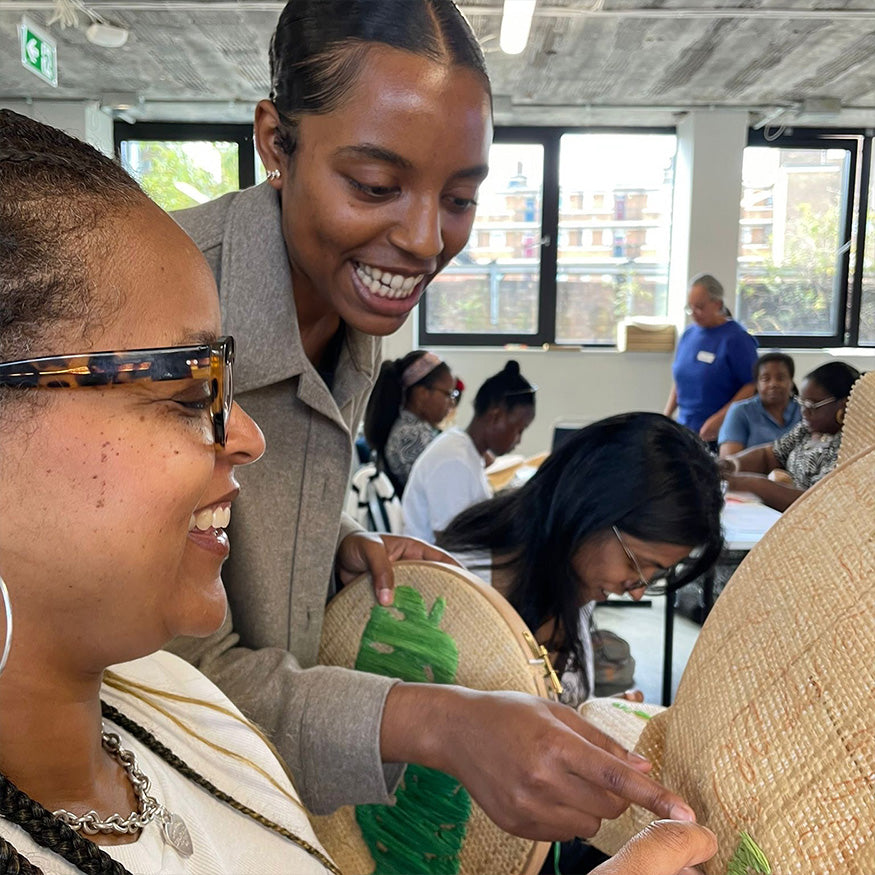Get 10% off with code:

St Lucia, also known as the Helen of the West Indies, is a captivatingly beautiful Caribbean Island, known for its striking natural landscape. Hike through lush jungles and rainforest to discover hidden mineral baths, soak in volcanic mud at the “world's only drive-in volcano” or set sail on crystal-clear waters teeming with coral reefs and colourful fish. The island’s history means that it has been influenced by African, indigenous Caribbean, French and British cultures, and this is seen through the food, language, and landmarks on the island. St Lucia is the perfect destination, whether you're seeking adventure amidst breathtaking landscapes like the geologic wonder of the Pitons, or simply want to indulge in tropical bliss on pristine beaches.
St Lucia: Helen of the West Indies
| Size: 238 sq miles | Official Language: English |
Population: 180,567 (2024) |
National Dish: Green Figs & Salt Fish |
Capital City: Castries |
National Bird: St Lucia Parrot |
Independence Day: 22nd February |
National Flower: The Rose and the Marguerite |
St Lucia Map & St Lucia Flag


This map of St Lucia shows the teardrop-shaped island located between the Caribbean Sea and the Atlantic Ocean. St Lucia is the second largest island of the Windward group in the Lesser Antilles. The map also shows two tiny islands in the Atlantic Ocean off the south-eastern coast, they are a protected nature reserve.
The blue background represents the surrounding waters, the Caribbean Sea & Atlantic Ocean. The yellow represents the Caribbean sunshine. The black & white colours symbolize the European & African heritage & harmony between the races. The triangles in the flag are symbolic of the Pitons.
St Lucia Landscape & Geography
St Lucia is a teardrop-shaped located in the Windward group of islands in the Caribbean Sea. The island is of volcanic origin and is filled with lush tropical jungle and rainforest, this is most seen in the iconic landscapes of the town of Soufriere. Here, the twin peaks of the Pitons pierce the sky. This breathtaking volcanic duo was designated a UNESCO World Heritage Site in 2004 and attracts travellers from across the world who visit to witness their majesty. Although the Pitons may be the most recognisable peaks of St Lucia, the highest point is Mount Gimie at 959 metres.
St. Lucia's appeal extends beyond the Pitons. The landscape transforms with each turn as you cross the island's 27-mile length and 14-mile width. The west coast basks in the calm embrace of the Caribbean Sea, offering idyllic bays and sun-kissed beaches perfect for soaking up the island's warmth. On the other side of the island, the east coast meets the Atlantic Ocean’s might, with much more choppy and dramatic waves.

Back in the town of Soufriere, hot springs bubble, attracting visitors and locals to indulge in a natural mineral-rich bath, slathering themselves with mud to enjoy the benefits of its health benefits. The dormant volcano, La Soufrière, last erupted in 1766 and serves as a potent reminder of the island's fiery past.
But St. Lucia's vibrancy extends beyond its geology. The island boasts over 150 bird species, including the stunning Saint Lucian parrot, the island's national bird. Agoutis (a member of the rodent family) scamper through the undergrowth, while mongooses, opossums, and bats flit through the shadows. Even reptiles find sanctuary in this lush paradise, adding to the island's captivating wildlife.
St Lucia Culture
The island of St. Lucia has been home to a variety of people throughout its history. The Arawak people originally named it "Iyonola," while the Carib settlers later renamed it "Hewanorra." The island's culture is an exciting blend of English, French, African, Indian, and Caribbean heritage, with each group leaving a lasting impression on the island. Due to the island's history of changing hands between French and English colonists, it has earned the nickname "Helen of the West Indies." This has resulted in a diverse mix of languages, music, and cuisine that can be experienced throughout the island.

Much of the population is descended from enslaved Africans brought to the island during the transatlantic slave trade, and their influence is evident in the rhythms of the local music, the food, and the crafts of the island. Kwéyòl, a French-based Creole language, is spoken by a large portion of the population alongside English, the official language.
Every October, the island comes alive during Creole Heritage Month, a vibrant celebration of St. Lucian identity. The streets erupt in colourful parades, art exhibitions showcase the island's creativity, and the air is filled with the sounds of music, theatre, and lively discussions. Creole cuisine, a delectable fusion of African, French, and Caribbean influences, takes centre stage, offering a tantalizing taste of the island's rich cultural heritage.
St Lucia Carnival, Festivals & Events
Many exciting events take place in Saint Lucia throughout the year. From lively street jump-ups and fish fries to cultural celebrations and music festivals, you can immerse yourself in the local traditions and learn about the fascinating heritage of the region. Here is a list of some of the festivals and events that you can experience while in St Lucia:
Saint Lucia Jazz & Arts Festival
April/May
A popular jazz festival in the Caribbean, the Saint Lucia Jazz & Arts Festival showcases top modern jazz performers in both intimate venues and public settings throughout the island.
Saint Lucia Carnival
July
The streets of St Lucia come alive with vibrant music, colourful costumes, and lively calypso during the Carnival season. There are various competitions held, including the Steel Pan Competitions, several community events, and a calendar of parties and fetes to keep everyone entertained. The season reaches its peak with an exciting two-day street parade of live bands and DJ music, showcasing stunning Carnival costumes, and radiating the joyous and energetic merriment typical of Caribbean carnivals that celebrate the region's rich history, culture, and creativity.
La Rose Flower Festival
August
There are two Flower Festivals that take place annually in Saint Lucia. These festivals, known as "La Rose" and "La Marguerite," celebrate the island's rich cultural history and heritage. The festivals represent a historical rivalry between communities, with each one showcasing the virtues of their respective flower. During "La Rose," members dress in red and create stunning displays made of roses.
Creole Heritage Month
October
Since 1981, a nationwide festival has been celebrated to honour French Creole Heritage and the richness and diversity of Saint Lucia's cultural, ethnic, and artistic heritage. The month-long celebration involves music, dance, cuisine, and art. The festival features musical and theatrical performances, seminars, lectures, street parties, and art exhibitions. The festival culminates with the celebration of Creole Day, also known as Jounen Kwéyòl.
La Marguerite Flower Festival
October
Also referred to as Fete La Marguerite, this is the second annual flower festival where the La Marguerite members dress up in purple and create creative displays of the Marguerite flower while singing traditional songs.
National Day
December 13
The Festival of Light is celebrated on December 13th, which is also the Feast of Saint Luce, Patron Saint of Light. The festival commemorates the triumph of light over darkness, symbolizing the victory of good over evil and the renewal of life.
St Lucia Food
St. Lucia's rich mix of cultures is reflected in the island’s cuisine. Pan-Caribbean classics mingle with international influences, offering a culinary adventure for every palate. Dive into the local life at a "fish fry," where succulent seafood like snapper, lobster, and crab sizzles on massive grills, ready to be eaten at communal picnic tables under the warm island sky.
On the island, Rodney Bay village is lined with modern, high-end eateries serving international foods. But no St. Lucian culinary journey is complete without savouring the island's signature dish: green figs and saltfish. This dish features green bananas simmered with salt cod, infused with a blend of herbs and spices. Breadfruit, a starchy staple with a hint of sweetness, can add another dimension to the plate, alongside other local favourites like yams, plantains, and cassava.
After the meal, you may want to quench your thirst with Piton, the island's beloved beer, or sip on a smooth St. Lucian rum, available as white rum, gold rum, or spiced rum. From fiery peppers to fragrant spices, every bite and sip in St. Lucia is an invitation to explore the island's rich heritage and vibrant spirit.
Things To Do in St Lucia
St Lucia offers something for everyone, whether you're seeking adventure, relaxation, or a taste of local life. Here are some ideas to get your St Lucian itinerary started:
Hike up the iconic Pitons if you’re feeling adventurous! The Pitons are a UNESCO World Heritage Site, and climbing up the Pitons is a memorable activity for any trip to St Lucia. The hike up Gros Piton can take between 3 to 6 hours each way, so it’s not for the faint-hearted, but you’re rewarded at the top with breathtaking views of the island and the Caribbean Sea. If you’re not looking for a hike, you could go on a catamaran sightseeing tour to see the Pitons from the water.
Zipline through the St Lucian rainforest. Soar through the lush rainforest on a thrilling zipline adventure, spotting exotic birds and waterfalls along the way.

Go scuba diving or snorkelling at Anse Chastanet. Explore the vibrant coral reefs teeming with marine life, and colourful fish. Anse Chastanet is a fine curving beach, the snorkelling here is said to be some of the best on the island.
Sip cocktails and laze on Sugar Beach. Soak up the sun on one of the most famous beaches on the island, situated between the two pitons, or choose from one of the many St Lucian beaches like Reduit Beach.
Explore the town of Soufriere and visit the Sulphur Springs. Take a mud bath and soak in the natural hot springs at the Sulphur Springs, a volcanic geothermal site. Soufriere is said by some to be the heart and soul of St Lucia, explore the town and the breathtaking landscape including the Pitons that guard the town.

Enjoy a gentle hike through gorgeous landscapes at the Tet Paul Nature Trail. Take a hike on this community-run scenic nature trail. Be guided through to see an organic farm, a view of the pitons and gain insights into traditional local life.
Have a picnic lunch and learn about the history of St Lucia at Pigeon Island National Park. Pigeon Island is a former island that was joined to the mainland in the 1970s, visit to view the fascinating historic sites. Pigeon Island National Park is a great place to explore with paths winding around historic remains or enjoy guided tours which can be arranged.
Dance the night away at Gros Islet’s famous Friday night jump-up. Every Friday night at Gros Islet, locals and tourists get together to dance to the rhythm of calypso, zouk, and reggae. Enjoy food from stalls selling ribs, fish, and jerk chicken and wash it down with a Saint Lucian rum punch or a local Piton beer.

Make chocolate, bean-to-bar style, with St Lucian grown cocoa at Rabot Estate. Rabot Estate is Saint Lucia's oldest working cacao farm. They offer a bean-to-bar experience where you can make chocolate from roasted cacao beans and taste the cacao pulp from a freshly cut pod. They also offer a tree-to-bar experience where you also get to head into the rainforest for a tour of the cacao groves and learn about every step of a cacao bean's journey from seedling to chocolate. There is also a modern restaurant on site that offers cocoa-inspired cuisine.
See the work of the island’s famous wood sculptor at Eudovic’s Art Studio. Vincent Joseph Eudovic is a renowned master carver, and you can see his work in the amazing art gallery and watch the carvers in the workshop.
This is just a taste of what St Lucia has to offer. With its stunning scenery, friendly locals, and endless activities, this island paradise is sure to leave you with memories that will last a lifetime.
Your St Lucia
We're passionate about celebrating the Caribbean, from its vibrant landscapes, delicious foods, and rich history & cultures. While travel guides and online research offer insights, nothing beats first-hand experiences.
That’s why I’m reaching out to you! Whether you’ve been to St Lucia as a visitor or have lived there, we’d love to hear about the island through your eyes - the beautiful beaches, the hidden waterfalls, the lively markets, and the sunsets that paint the sky. Your story and image might be featured on our blog or social media, inspiring others to discover and learn more about the Caribbean. If you'd like to get involved, just click here.
Get ready to dive into St Lucia through the eyes of its biggest fans! I can't wait to include what you share. For now, here is my contribution, my St Lucia moment from when I visited in 2019.


“One of my favourite days in St Lucia was visiting the market in Castries, and seeing the work of local craftspeople at Eudovic’s Art Studio and Howelton Estate” Tihara, London
“I recommend the bean-to-bar chocolate-making experience at Rabot Estate. You also get this beautiful view of the Pitons from the restaurant there!” Tihara, London
How to share your St Lucia...
If you'd like to see your island story and image featured on our blog or social media, just click here for more information on how to get involved.
Sources and Further Reading
Learn more about St Lucia:
Featured image by Tihara Smith
This article is a result of my interest and fascination with the island of St Lucia and my love for the Caribbean region. I have gathered information through research both online and in books to compile this blog post to share what I've discovered with you. However, I'm only human, and I may have missed something in my research, so if you happen to come across any information that appears to be incorrect or outdated, please do let me know by sending an email to hello@tiharasmith.com. Your input will be much appreciated and will help us improve this blog post for everyone's benefit.









